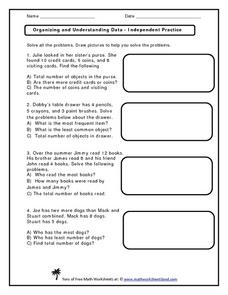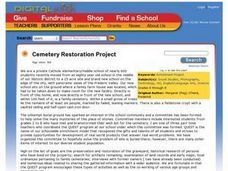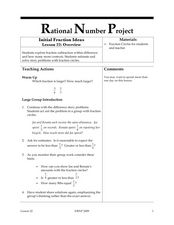Curated OER
The Girl Who Loved Wild Horses
Second graders use literature journals and discussion groups to summarize and improve their reading comprehension. In this reading skills lesson, 2nd graders discuss animals they've loved and read the story The Girl Who Loved Wild...
Curated OER
Organizing and Understanding Data - Independent Practice
Provide your first graders with an opportunity for independent practice organizing and understanding data. The ten story prompts on this three-page worksheet asks learners to solve problems involving concepts of the total number of...
Curated OER
Counteracting Media Stereotyping
Discuss media stereotypes with your emerging consumers. They view a television program to identify gender bias. After discussing the clip as a class, each learner writes a story showing more equitable roles. Or consider having them...
Curated OER
Cemetery Restoration Project
Who is buried in this tomb? Trek to a local cemetery, take pictures of markers, explore records, and conduct interviews to bring to life the stories behind the stones. Use Olympus and Tool Factory to coordinate and gather information...
Curated OER
Vandalism leads to locked bathrooms
Students research bathroom vandalism in other schools like Freedom High after reading an article about Freedom High and their situation. Students then decide if their school has a similar problem and interview administrators and janitors...
Curated OER
Christmas Addition
Finding the sums up to 5 will be fun, with this Christmas themed activity. Learners add Christmas items together, write the corresponding number sentence, and their answers. There are 3 problems to solve.
Curated OER
The Story that Tracks Tell
Eighth graders observe and investigate animal tracks. They draw prints for local animals and switch with another student to guess the animal, identify animal tracks in a nearby wood lot, create plaster casts of the tracks, and write a...
Curated OER
Rainforest Problem
Third graders use a hypothetical story in order to create a context for the lesson. The story presents a problem that needs to be solved. They write a letter to a government official as part of the lesson.
Curated OER
Problem Solving
Young scholars listen to a story about a cat and dog fighting all the time. They must develop and explain a machine that stops the cat and dog from fighting. Then they have a discussion about machines and inventions.
Curated OER
Math Maven's Mysteries
In these story problem worksheets, learners read the story problem 'The Case of the Virtual Pet 2000' and use the information within the story to help them find which character had enough time to take the toy. Students use subtraction to...
Curated OER
Tango's Story
Fifth graders listen to "Grandfather Tang's Story" and use tangram pieces to create animals described by the main character.
Curated OER
Math Stories 1
Second graders use technology to draw shapes or select pictues to represent an addition or subtraction equation. They also write the equation, and a story that matches the equations.
Curated OER
Exercise Require Mathematical Operation 2
In this math skills worksheet, students solve 1 multiple choice problem that requires them to read a story problem and select the appropriate number sentence that represents the problem. Students may view the correct answers.
Curated OER
Working Backwards
Sixth graders make up their own math problems. There is only one restriction. That is, the answer has to be the one you are going to give them in a sealed envelope. The problems that they make up can be anything they like. Let Students...
Curated OER
Miles Of Smiles
Students investigate basic mathematical properties to solve multiplication and division problems. They solve word problems that are part of the lesson. Students are required to give written or oral justification for how they solve each...
Curated OER
Three Squirrels and a Pile of Nuts
Students solve word problems using a spreadsheet, strategies, and algebraic variables. They disuss the given problem, which can be printed, write the unknowns, and employ the strategies into a spreadsheet. Students then use Microsoft...
Curated OER
Solving a Community Problem Through Education
Fourth graders examine and compare Indian and American culture in order to develop a better understanding of both.
Curated OER
Initial Fraction Ideas Lesson 21: Overview
Students become familiar with the process of subtracting fractions. In this subtracting fractions lesson, students complete examples and then write a story problem. Students continue to practice while sharing their problems.
Kelly's Kindergarten
July Daily Activities
Concerned about your learners forgetting what they've learned during summer vacation? Use a learning guide to keep them busy every day of the week. With activities about writing, drawing, counting, adding, and time, your kids will be...
Curated OER
Indiana Applied Skills Assessment Sample
In this Applied Skills Assessment worksheet, 5th graders complete a sample state assessment for Language Arts and Mathematics for 5th graders. They read a writing prompt and complete a writing activity that follows, answer various types...
Curated OER
The Tortoise And The Hare
Students use the children's story of The Tortoise And The Hare in order to investigate the graphing of equations. The story is converted to an algebraic word problem for them to solve. Students investigate the relationships of data and...
Curated OER
Shaping Up!
Kindergartners are introduced to basic shapes. Learners spend 45 minutes a day in geometry centers carrying out the activities outlined in this ambitious plan. There are games, hands-on activities, interactive websites, art projects,...
Curated OER
Sally's Super Day
Second graders engage in a lesson plan that is about having a super day with an example of a fictitious child. They read "Sally's Super Day" and reflect upon the events and how they affected the character and the outcome of the story....
Curated OER
Stop Signs, Musical Notes, Letters & Logos: Designing Symbols
Students develop an awareness of environmental print, such as signs, logos, brand names, and other print and non-print items that the children see and read in their neighborhood each day. They then engage in active problem solving as...























